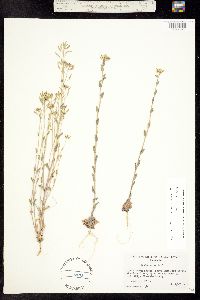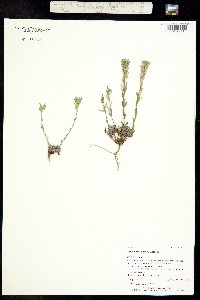Draba aurea
|
|
|
|
Family: Brassicaceae
golden draba, more...Golden Whitlow-Grass, golden whitlowgrass
[Draba aurea var. aurea, moreDraba aurea var. leiocarpa (Payson & St. John) C.L. Hitchc., Draba aurea var. neomexicana (Greene) Tidestrom, Draba aureiformis Rydb., Draba bakeri Greene, Draba decumbens Rydb., Draba luteola Greene, Draba luteola var. minganensis Vict., Draba minganensis (Victorin) Fern., Draba neomexicana Greene, Draba neomexicana var. robusta , Draba surculifera , Draba uber] |
Perennials; (not cespitose); caudex simple or branched; not scapose. Stems sometimes branched distally, (0.5-) 1-3.5(-5.2) dm, pubescent throughout, trichomes simple (non-crisped), 0.4-1.3 mm, and 3-6-rayed ones, 0.1-0.5 mm. Basal leaves rosulate; petiolate; petiole (distinct or obscure) ciliate, (trichomes simple, to 0.8 mm); blade oblanceolate to obovate, (0.4-)1-3.7(-5) cm × (1-)2-7(-10) mm, margins entire or denticulate, surfaces pubescent, trichomes stalked, (2-)4-7 (or 8)- rayed, 0.2-0.5(-0.6) mm. Cauline leaves 5-20 (-26); sessile; blade oblong to lanceolate or ovate, margins entire or dentate, surfaces pubescent as basal, sometimes adaxially with simple trichomes. Racemes (10-)18-52(-72)-flowered, usually bracteate on proximalmost 1-12(-17) flowers, rarely ebracteate, elongated in fruit; rachis not flexuous, pubescent as stem. Fruiting pedicels divaricate-ascending to ascending or suberect, straight, 3-13(-20) mm, pubescent as stem. Flowers: sepals (green or yellowish), oblong, 2.2-3 mm, pubescent, (trichomes simple and branched); petals yellow, oblanceolate, 3.5-5 × 1.5-2.5 mm; anthers ovate, 0.4-0.5 mm. Fruits (often subappressed to rachis), lanceolate to linear-lanceolate or narrowly oblong, slightly twisted or plane, flattened, (6-)9-14(-17) × 2-3.5 mm; valves pubescent, trichomes simple and short-stalked, 2-4-rayed, 0.05- 0.3 mm; ovules 28-38(-44) per ovary; style 0.5-1.2 (-1.5) mm. Seeds oblong, 0.9-1.3 × 0.5-0.7 mm. 2n = 74. Flowering Jun-Aug. Rock outcrops, talus, damp gullies and meadows, subalpine conifer woodlands, alpine slopes and turf, tundra, road banks, river gravel; (0-)700-4200 m; Greenland; Alta., B.C., Man., Nfld. and Labr. (Nfld.), N.W.T., Nunavut, Ont., Que., Sask., Yukon; Alaska, Ariz., Colo., Idaho, Mont., Nev., N.Mex., S.Dak., Utah, Wash., Wyo. Draba aurea is extremely variable in plant size, number of cauline leaves, number of bracteate flowers, style length, and fruit size, shape, orientation, twisting, and indumentum. Much of the variation in the number of bracts, style length, fruit twisting, and growth habit occurs in Greenland, where the type specimen was collected and where the species is found near sea level. The highly deviant chromosome counts (e.g., 2n = 40 + 1, 64, 82) listed by R. C. Rollins (1993) and S. I. Warwick and I. A. Al-Shehbaz (2006) are mostly unvouchered and have to be disregarded; counts of 2n = ca. 80 have been re-assigned to Draba glabella. Published (G. A. Mulligan 2002) and unpublished counts made by Mulligan and M. D. Windham from Alaska, British Columbia, Colorado, Quebec, Utah, and Yukon indicate that the most common chromosome number of D. aurea is 2n = 74 (or 72). This suggests that the species is an allopolyploid (hexaploid or higher), incorporating genomes from both euploid and aneuploid lineages (M. A. Beilstein and Windham 2003). Detailed cytological and molecular studies are much needed to fully understand this widely distributed and highly variable species.
General: Perennial; stems 1 to few, not scapose, 5-30 cm tall, erect or frequently decumbent, simple; herbage grayish green, pilose, with simple, forked, stellate, and branched hairs; caudex simple or branched. Leaves: Basal (forming a rosette) and cauline, alternate, simple, the basal blades oblanceolate to spatulate, 1-5 cm long (including the short petiole), 2-7 mm wide, the cauline blades ovate to lanceolate, reduced, pubescent with various types of hairs, margins entire to occasionally dentate, apex acute to obtuse; basal blades petiolate, cauline blades sessile or petiolate. Flowers: Inflorescence a raceme, 30-80 flowered, dense, elongating in fruit, pubescent with simple to forked hairs; pedicels ascending, 5-10 mm long; sepals broadly ovate, 1.7-3.3 mm long; petals oblanceolate, 4-7 mm long, pale yellow; flowers February-May. Fruits: Silique, lanceolate, 9-14 mm long, 2-3.5 mm wide, usually twisted, often pubescent; mature style 0.5-1.5 mm long; seeds numerous. Ecology: Montane habitats, subalpine conifer forests, aspen woodlands, and above timberline; 1500-3700 m (5000-12000 ft); Apache, Cochise, Coconino, Graham, and Pinal counties; Canada, north-central, northwestern, to southwestern U.S. Notes: Draba helleriana (Heller-s draba) is a perennial, stems 1 to several, 5-40 cm tall, leafy up to the inflorescence, and often branched above; herbage is grayish green, pubescent with simple and stellate hairs; basal and cauline leaves are lanceolate to obovate, 1-6 cm long, the margins entire to shallowly dentate; racemes bear several to many flowers, the petals 4-8 mm long, yellow; fruit is a silicle to silique, 4-15 mm long, usually twisted, pubescent to glabrous; mature style is 1.5-3.5 mm long. It occurs in rocky crevices and open to wooded slopes in montane regions at 1800-3500 m (6000-11500 ft). Editor: Springer et al. 2008 |


_tn.jpg)







































































